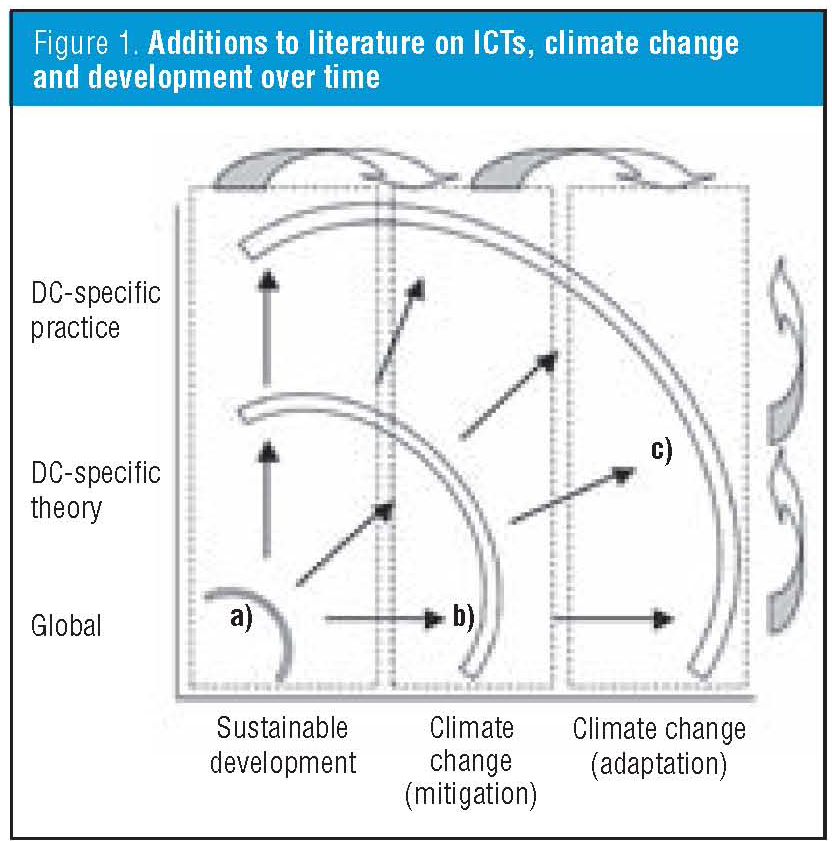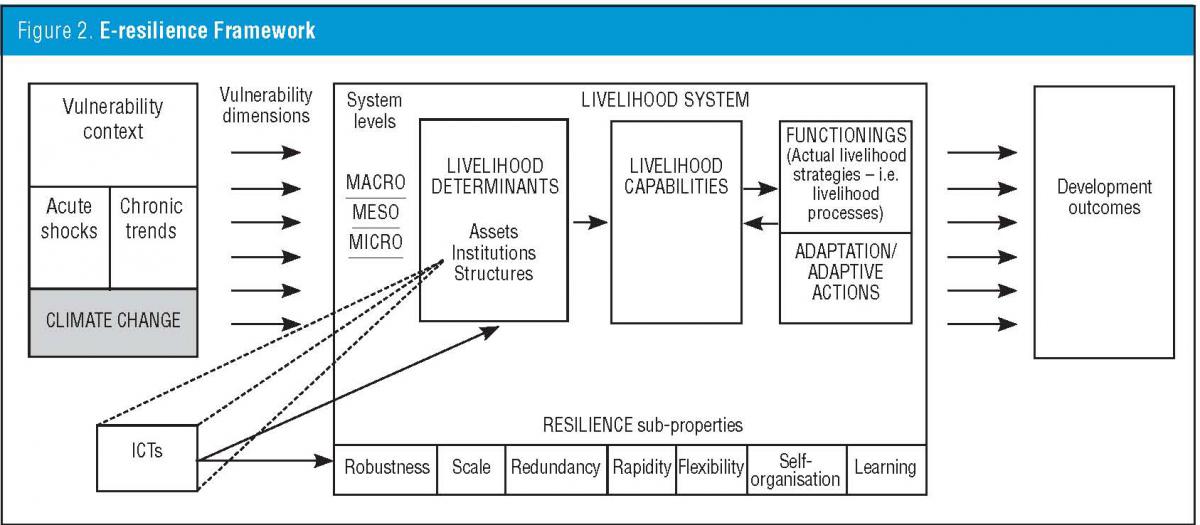ICTs and climate change research: The emerging development agenda
| Attachment | Tamanho |
|---|---|
| GISW2010ThematicICTsandClimateChangeResearch_EN.pdf | 1.88 MB |
Organization
Website
Introduction
Climate change is likely to exacerbate the poverty and marginalisation of developing country populations. Yet those same populations increasingly have access to information and communications technologies (ICTs). How can we characterise the research work done so far linking ICTs, climate change and development, and what should be the future research priorities?
The first part of this report will overview the emergence of a development agenda within ICTs and climate change research to date. The second will identify emerging research ideas, including the argument that “e resilience” represents the key concept linking the ICT, climate change and development fields. Finally, the report will identify emerging themes for future research (and practice).
Understanding work to date
The relation between ICTs and climate change constitutes a relatively new area of enquiry. In the 1990s, there were broad reflections on the linkages between the information society and sustainable development. These became increasingly focused on the role of ICTs in climate change mitigation and monitoring, and more recently, on adaptation. In more detail, we can see three distinctive, yet interrelated strands that have so far characterised research at the intersection of ICTs, climate change and development.
Sustainable development and the environment
Research in this strand addresses the linkages between ICTs and the achievement of environmental sustainability from a global perspective, looking at issues such as achievement of the Millennium Development Goals (MDGs) and the potential of these technologies in natural resource management and monitoring. 1 Although sources in this strand emerged without making explicit reference to climate change, they have set an important foundation for analysis of the role of ICTs vis-à-vis environmental sustainability.
Mitigation
Reflecting increasing global awareness about the effects of CO2 emissions, this strand is characterised by research that tackles, with increased technical specificity, climate change mitigation. Driven primarily by developed countries’ priorities in the field, it focuses on the role of ICTs in reducing CO2 emissions through carbon displacement (e.g. telework, dematerialisation), 2 and the use of energy-efficient applications in “smart” telecommunications, power, transportation and services industries, among others. 3
Adaptation
Following publication of the Intergovernmental Panel on Climate Change (IPCC) 2007 report and growing concern over the effects of climate change on vulnerable populations, this research strand is the most recent to emerge. It tackles the priorities of developing countries through adaptation (i.e. recovery and adjustment in the face of climate change). Initial evidence on the potential of ICTs, particularly mobile phones, is starting to be reflected, 4 along with examples of applications that can strengthen local livelihoods, social networks, decision-making processes and dissemination of information relevant to local adaptive strategies.
The ongoing, non-linear evolution of these strands is summarised in Figure 1. The x axis reflects the evolving focus of research on the main strands described above. The y axis reflects the development of different research approaches: from global to more developing country-relevant (or DC-specific), and from theory to practice.

As Figure 1 suggests, the potential of ICTs to contribute to climate change adaptation in developing countries remains the least researched, particularly in relation to the maintenance of sustainable livelihoods in the midst of a changing climate.5
Nonetheless, research is beginning to tackle developing country priorities from new angles, and the concept of “resilience” is rapidly emerging as an issue of increasing relevance.
Emerging research
The effects of climate change magnify existing development challenges, having a greater impact on vulnerable populations. 6 Because of this, the potential effects of climate change must be analysed as part of the broader development stressors and resource constraints which ultimately determine a community’s ability to respond, both in the short and long term, to the challenges posed by extreme weather events and climatic uncertainty.
One important area of research will therefore be to understand the links between ICTs and the vulnerability dimensions (livelihoods and finance, socio-political conditions, food security, health, water supply, habitat and migration) 7 that are exacerbated by the effects of climate change. Another will be to look at the flipside of vulnerability: at the contribution of ICTs to the resilience of developing country communities, which underpins their ability to survive and adapt in the face of climate change.
ICTs and resilience: “E-resilience”
Defined as the ability of a system to withstand, recover and change in the face of an external disturbance 8 (such as acute or chronic climate change), resilience constitutes an important property of livelihood systems which, through a set of seven dynamic sub-properties (robustness, scale, redundancy, rapidity, flexibility, self-organisation and learning) can enhance adaptive capacity.
As Figure 2 illustrates, there are therefore two routes to analysing the role of ICTs vis-à-vis climate change adaptation. First, through the dynamic links of ICTs with livelihood assets, institutions and structures, in this way creating capabilities that contribute to adaptive actions. The second, less-explored route, focuses on “e resilience”: “a property of livelihood systems by which ICTs interact with a set of resilience sub-properties, enabling the system to adapt to the effects of climate change.” 9
MCO: Vulnerability context Vulnerability dimensions System levelsAcute shocks Chronic trends Actual livelihood strategies – i.e. livelihood processes) Development outcomes

The “E-resilience Framework” emerges from recognition that the complex linkages existing between climate change, adaptation processes and development outcomes need to be analysed from a systemic perspective. 10 This allows identification of the different components, processes and properties, as well as the interactions that play a role in the realisation of adaptation within vulnerable settings, facilitating the identification and analysis of the potential contribution of ICTs.
Key areas for future research
Emerging experiences from vulnerable communities in Asia, Africa, Latin America and the Caribbean point to use of community radio, mobile phones, the internet and other ICTs as an increasingly important part of climate change responses. They also indicate the value of an e resilience approach, since this moves beyond shallow surface effects to understand the way in which ICTs can – but often fail to – have a deeper and systemic effect that will help communities and nations to sustain.
Where failure occurs, past work in the ICT for development (ICT4D) field indicates it arises from a mismatch between design requirements and on-the-ground realities, including issues such as lack of coordination between communities and local/municipal/national institutions; barriers of access that cause exclusion and marginalisation; and lack of capacity to undertake mitigation, monitoring and adaptation actions.
A key priority for future research will therefore be to understand both the opportunities but also the challenges for ICTs in enhancing community and national resilience, through their effects on the resilience sub-properties, including:
- Fostering robust livelihoods that are able to withstand shocks and maintain their performance under climatic fluctuations 11
- Broadening the scale of assets and structures that need to be accessed to cope and adapt to climatic occurrences
- Building redundancy and asset diversity
- Enabling rapidity in the access and mobilisation of resources needed to cope and adjust to the effect of hazards and variability
- Enabling system flexibility to undertake different actions and benefit from potential opportunities that may arise within a changing climate
- Facilitating systemic self-organisation in the face of external disturbances
- Generating learning, including skills and capacities that help respond to and prepare for future climate uncertainty.
Conclusion
Consideration of the development context, including prevailing vulnerabilities, is pivotal in determining the viability, appropriateness, and ultimately the sustainability of ICT-enabled responses to the changing climate. Further analysis of e resilience can help improve our understanding of the role of ICTs, and assist in identifying key areas in which these tools have greatest potential to strengthen adaptive capacities and livelihood strategies.
As research at the intersection of ICTs, climate change and development continues to evolve, developing country priorities and perspectives must become a central part of the debate, if the technology’s potential is to contribute to more holistic, inclusive responses to the challenges posed by climate change.
Notes
1 Felleman, J. (1997) Deep Information: The Role of Information Policy in Environmental Sustainability, Ablex Publishing Corporation, Greenwich, UK; Cohen, N. (1998) Greening the Internet: Ten Ways E-Commerce Could Affect the Environment and What We Can Do, Environmental Quality Management, 9 (1), p. 1-16.
2 ITU (2008) ITU and Climate Change. www.itu.int/themes/climate/docs/report/index.html
3 WWF (2002) Sustainability at the Speed of Light. assets.panda.org/downloads/wwf_ic_1.pdf; Pamlin, D. and Szomolanyi, K. (2005) Saving the Climate @ the Speed of Light: First Roadmap for Reduced CO2 Emissions in the EU and Beyond. assets.panda.org/downloads/road_map_speed_of_light_wwf_etno.pdf
4 Labelle, R., Rodschat, R. and Vetter, T. (2008) ICTs for e-Environment: Guidelines for Developing Countries with a Focus on Climate Change. www.itu.int/ITU-D/cyb/app/docs/itu-icts-for-e-environment.pdf
5 Ospina, A. V. and Heeks, R. (2010) Unveiling the Links between ICTs & Climate Change in Developing Countries: A Scoping Study. www.niccd.org/ScopingStudy.pdf
6IPCC (2007) Fourth Assessment Report (AR4). www.ipcc.ch Moser, C. and Satterthwaite, D. (2008) Towards Pro-Poor Adaptation to Climate Change in the Urban Centres of Low and Middle-Income Countries. www.iied.org/pubs/pdfs/10564IIED.pdf; Kalas, P. P. and Finlay, A. (2009) Planting the Knowledge Seed: Adapting to Climate Change using ICTs. www.bcoalliance.org/Climate-Change
7 These dimensions correspond to areas in which climate change-related manifestations are expected to have the hardest effects on vulnerable contexts, including natural habitats (e.g. desertification, land degradation), scarcer water resources (e.g. melting glaciers, sea level rise), decrease in agricultural production, health threats (e.g. heat- and cold-related illness, vector-borne and infectious diseases), as well as risks to human infrastructure and habitats (e.g. climate-related displacement and migration).
8 Magis, K. (2009) Community Resilience: An Indicator of Social Sustainability, Society and Natural Resources, 23, p. 401-416.
9 Ospina, A. V. and Heeks, R. (2010) Linking ICTs and Climate Change Adaptation: A Conceptual Framework for e-Resilience and e-Adaptation. www.niccd.org/ConceptualPaper.pdf
10 Nelson, D. R., Adger, N. W. and Brown, K. (2007) Adaptation to Environmental Change: Contributions of a Resilience Framework, Annual Review of Environment and Resources, 32, p. 395-419.
11 Carlson, J. M. and Doyle, J. (2002) Complexity and Robustness, Proceedings of the National Academy of Sciences of the United States of America, 99 (1), p. 2538-2545; Janssen, M. A. and Anderies, J. M. (2007) Robustness Trade-offs in Socio-Ecological Systems, International Journal of the Commons, 1 (1), p. 43-65.